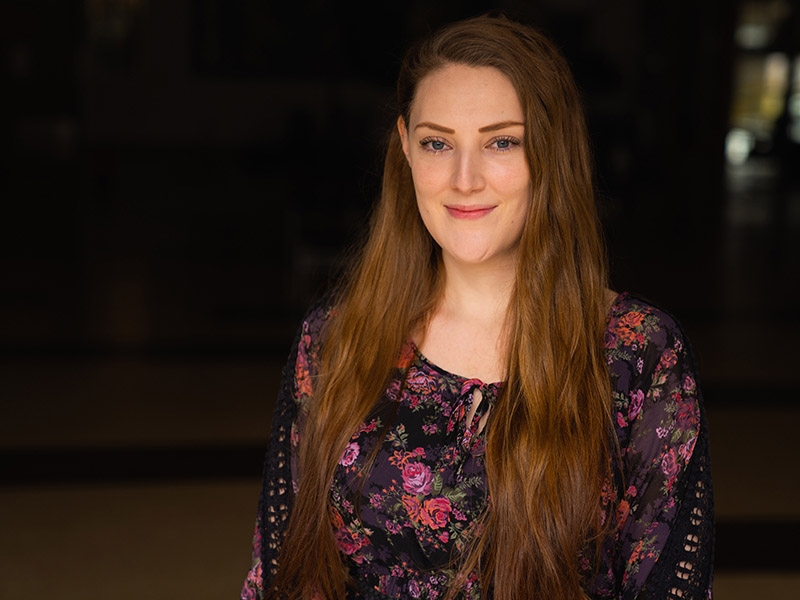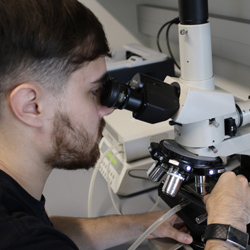
Physics Student is Melting Glass Ceilings
Editor’s Note: Nicole Wales discovered a passion for science while taking physics courses at Southwestern in 2016. The following story shares Nicole’s inspiring path from Coos Bay to a University of Oregon research lab, and on to MIT. To learn more about Southwestern’s Physics and Engineering program go to physics.socc.edu.
Story courtesy of University of Oregon, Oregon Quarterly, AroundtheO
––By Ed Dorsch, BA ’94 (English, sociology), MA ’99 (journalism), a staff writer for University Communications
Photos by Dustin Whitaker, University Communications
April 7, 2021
Nicole Wales will probably not be the only University of Oregon senior graduating this June with dreams of becoming a science professor. And there will also be others who represent the first in their family to attend college.
However, few of her fellow Ducks spent their spare time mapping their own brain using an MRI scan and learning code so they could research the physics of melting glass. What really sets Wales apart, though, are the challenges she overcame just to get to the university, let alone thrive as a scholar and researcher.
“I’m an underdog,” says the 28-year-old chemistry and physics major from Coos Bay. “My mom was a bartender and my dad was a diesel mechanic. There was never any expectation that I would pursue a college degree. But I decided to try anyway.”
While she was growing up, her family didn’t have a computer or internet access. But Wales worked hard at North Bend High School, earned a 3.93 GPA, graduated in 2010, and excelled at Southwestern Oregon Community College.
Then she faced the first of several difficult challenges that delayed—but never quashed—her promising academic career. In 2013, her father died by suicide.
“That was the day I hope will be the worst of my life,” Wales says. “I can’t even begin to describe the heartbreak. But I can say that I would eventually bust through this trauma with a relentless new drive.”
Then another setback. Wales suffers from Graves’ disease, an autoimmune disorder that affects the thyroid. After being dropped from her deceased father’s health insurance, she tried in vain to find coverage. But this was before current laws that regulate the coverage of preexisting conditions.
She was unable to get the prescription medication she needed. Left untreated, her condition culminated in a thyrotoxic storm—a life-threatening condition that could have been easily prevented.
“I woke up in the emergency room and didn’t know where I was,” Wales says. “Ambulance rides and staying overnight in the hospital are expensive. That was pretty tough. It took years of working, often two jobs at a time, to pay everything off.”
She worked at Taco Bell and Umpqua Bank. She had stints as a tugboat deckhand and a process server for local attorneys (Wales describes the latter as the most dangerous job she’s ever had). But she persisted, paid her medical bills, and returned to SWOCC to take more classes, even though she had earned her associate’s degree.
Wales explored becoming a pharmacist, shadowed a local surgeon, and continued learning until she ran out of science courses to take. Then she heard about the UO’s Scholarships for Oregon Scientists, a program for incoming physics, chemistry, and biochemistry majors.
“I thought I might as well try,” Wales says. She was accepted and enrolled at the university in 2017.
“Once I got that scholarship for the UO, I knew I couldn’t pass it up,” she says. “That was amazing. It changed everything for me. Once I got to campus, things started to pick up.”
But adjusting to university life was challenging. Wales felt alienated and struggled to overcome a misconception that she didn’t belong or have what it takes to succeed—imposter syndrome.
“Between the ages of 19 and 24, I was fighting every step of the way just to get an inch closer to school,” Wales says. “This was in sharp contrast to most of my peers. For them, college was simply something they were expected to do.”

Still, she persisted, receiving Diversity Excellence and Mercer Family Foundation scholarships. And she volunteered with the Boys and Girls Club of Emerald Valley, working to help girls interested in science.
Wales decided to major in chemistry, and thanks to a Presidential Undergraduate Research Scholarship, she studied solar cells with Mark Lonergan, a professor of chemistry and biochemistry. Then she discovered physics, adding a second major even though it required another year of school.
Elsa Johnson taught Wales in a physics lab course and became a mentor, advising her about research, academics, and careers.
“I’ve had some great students, but Nicole just stood out,” says Johnson. “She’s gone through so much tragedy, but she kept on going. I knew she was smart, so I encouraged her because I knew she could handle pressure.
“I’ve seen hard-working, smart students waste energy doubting their abilities because they don’t receive much feedback other than a grade. If they lack confidence, it’s difficult for them to ask for advice or promote themselves. Most likely no one is encouraging them to join this lab or apply for that internship. As a teacher, I tried to push talented students, particularly those like Nicole who needed encouragement, to get their names out there and apply.”
Wales met Associate Professor Eric Corwin in fall 2019 when she started Foundations of Physics, a three-course sequence. Nicole was a standout student, Corwin recalls; when Wales asked if she could join his lab, his answer was an exuberant yes.
Wales was accepted to the National Science Foundation’s Research Experiences for Undergraduates summer 2020 program at the Massachusetts Institute of Technology but had to cancel the trip because of the pandemic.
However, that gave her more time to help Corwin investigate the glass transition problem, a physics mystery that continues to vex researchers worldwide. Glass may be a common and widely used material, but what exactly happens at the molecular level when it changes from solid to liquid (and vice versa) remains unclear.
Consider a pitcher of ice water, says Corwin: The ice cubes are clearly solid, with a crystal structure that’s visibly different from liquid water. As the ice cubes melt, they become liquid. The water exists in the pitcher in two distinct forms.
Glass is dramatically different. In solid form, it’s rigid like crystal but—unlike crystal—the molecules are disordered. And glass shifts from solid to liquid very gradually as it heats. That’s why a glass blower can create artistic shapes. Try that technique with ice, and you’ll just get wet.
This gradual, gooey transition is one reason glass is such a useful material. Understanding this transition better could lead to innovations in manufacturing. Imagine, says Corwin, cars produced by injecting molten metallic glass into a mold.
Pandemic precautions forced Wales to change her glass research plans. Instead of lab-based experiments, she focused on computer coding, which enables her to work from home and conduct experiments using particle simulations. The project is part of her Ronald E. McNair Scholarship, a prestigious national program to help students from underrepresented segments of society earn graduate degrees.
She’s exploring “jamming,” a phenomenon related to the glass transition. Grains of sand can flow through your fingers like liquid. Pack that sand tightly in a bucket, though, and it will act more like a solid because those grains are jammed.
Wales maps out thousands of possible configurations of imaginary particles in three dimensions, exploring how one packing leads to another. What happens, for instance, to packed sand when you give it a bump? Do all the grains of sand rearrange? Or are there a few grains of sand, buried deep in the packing, that move much more than any others? The answer could reveal secrets about the glass transition.
“I had to teach myself to program with Python over the summer,” Wales recalls. “My frustration trying to communicate with my computer drove me to tears more than a few times. I like to stand on my own two feet. That’s the biggest hurdle I’ve had to overcome in research. I love figuring things out by myself, and I’m stubborn about that to a fault. I don’t give up—ever. I may not be the smartest person in any given room. But I’m usually the most tenacious.”
This fearlessness and perseverance is a great combination for a researcher, according to Corwin.
“Nicole is willing to try new things that she doesn’t know how to do yet,” he says. “That can be scary. But it’s important in physics to push beyond the familiar and the comfortable. She also has the ability to accomplish her research goals. The combination of these two traits makes her special as a scientist.”
Wales hopes to someday join a university faculty, combining her interests in research and teaching with an irrepressible passion for science.
“I genuinely love physics and the challenges it presents,” she says. “Physics is literally everywhere, everything, and always working!”
As she looks back on everything she’s gone through and the accomplishment of earning her diploma, Wales continues looking forward. She’s applied to 22 graduate programs, including MIT, Stanford, and the UO.
“Mom said, ‘Whatever you want to do, just do it,’” Wales says. “She’s very proud of me every day, even those days I don’t feel so special and great. My dad would be really proud, I know.”




